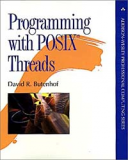Книга: Programming with POSIX® Threads
1.2.5 Thread safety and reentrancy
1.2.5 Thread safety and reentrancy
"Thread-safe" means that the code can be called from multiple threads without destructive results. It does not require that the code run efficiently in multiple threads, only that it can operate safely in multiple threads. Most existing functions can be made thread-safe using tools provided by Pthreads— mutexes, condition variables, and thread-specific data. Functions that don't require persistent context can be made thread-safe by serializing the entire function, for example, by locking a mutex on entry to the function, and unlocking the mutex before returning. Functions made thread-safe by serializing the entire function can be called in multiple threads—but only one thread can truly perform the function at a time.
More usefully, thread-safe functions can be broken down into smaller critical sections. That allows more than one thread to execute within the function, although not within the same part. Even better, the code can be redesigned to protect critical data rather than critical code, which may allow fully parallel execution of the code, when the threads don't need to use the same data at the same time.
The putchar function, for example, which writes a character into a standard I/O (stdio) buffer, might be made thread-safe by turning putchar into a critical section. That is, putchar might lock a "putchar mutex," write the character, and then unlock the putchar mutex. You could call putchar from two threads, and no data would be corrupted—it would be thread-safe. However, only one thread could write its character at a time, and the others would wait, even if they were writing to different stdio streams.
The correct solution is to associate the mutex with the stream, protecting the data rather than the code. Now your threads, as long as they are writing to different streams, can execute putchar in parallel. More importantly, all functions that access a stream can use the same mutex to safely coordinate their access to that stream.
The term "reentrant" is sometimes used to mean "efficiently thread-safe." That is, the code was made thread-safe by some more sophisticated measures than converting the function or library into a single serial region. Although existing code can usually be made thread-safe by adding mutexes and thread-specific data, it is often necessary to change the interface to make a function reentrant. Reentrant code should avoid relying on static data and, ideally, should avoid reliance on any form of synchronization between threads.
Often, a function can avoid internal synchronization by saving state in a "context structure" that is controlled by the caller. The caller is then responsible for any necessary synchronization of the data. The UNIX readdir function, for example, returns each directory entry in sequence. To make readdir thread-safe, you might add a mutex that readdir locked each time it was called, and unlocked before it returned to the caller. Another approach, as Pthreads has taken with readdir_r, is to avoid any locking within the function, letting the caller allocate a structure that maintains the context of readdir_r as it searches a directory.
At first glance, it may seem that we're just making the caller perform what ought to be the job of readdir_r. But remember that only the caller knows how the data will be used. If only one thread uses this particular directory context, for example, then no synchronization is needed. Even when the data is shared between threads, the caller may be able to supply more efficient synchronization, for example, if the context can be protected using a mutex that the application also uses for other data.
- Разработка приложений баз данных InterBase на Borland Delphi
- Open Source Insight and Discussion
- Introduction to Microprocessors and Microcontrollers
- Chapter 6. Traversing of tables and chains
- Chapter 8. Saving and restoring large rule-sets
- Chapter 11. Iptables targets and jumps
- Chapter 5 Installing and Configuring VirtualCenter 2.0
- Chapter 16. Commercial products based on Linux, iptables and netfilter
- Appendix A. Detailed explanations of special commands
- Appendix B. Common problems and questions
- Appendix E. Other resources and links
- IP filtering terms and expressions




